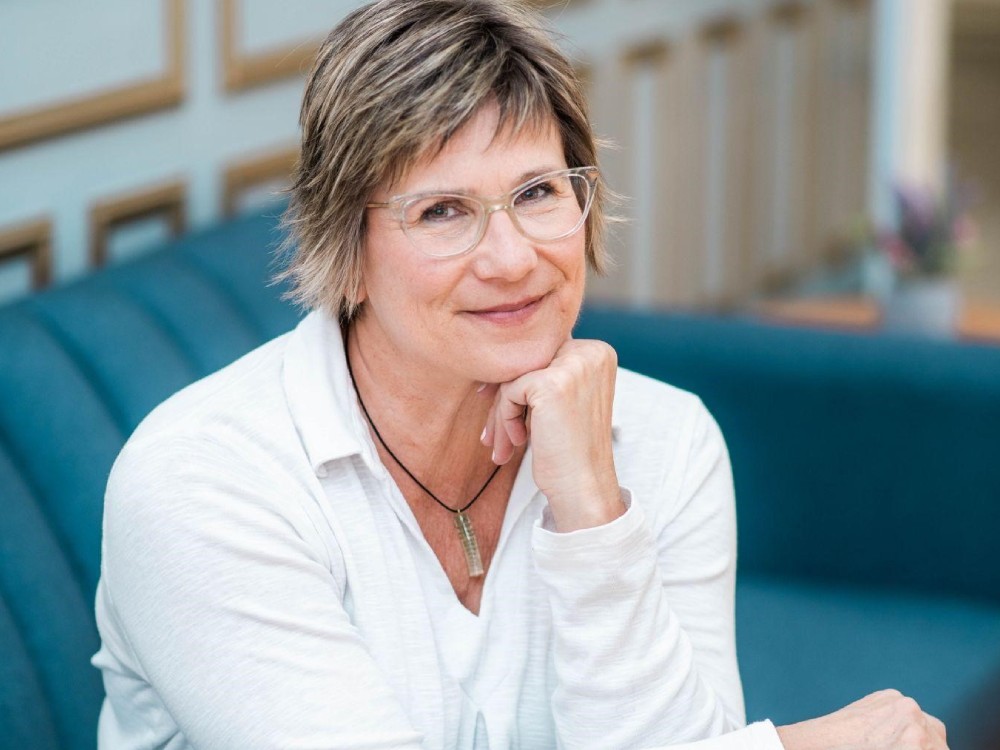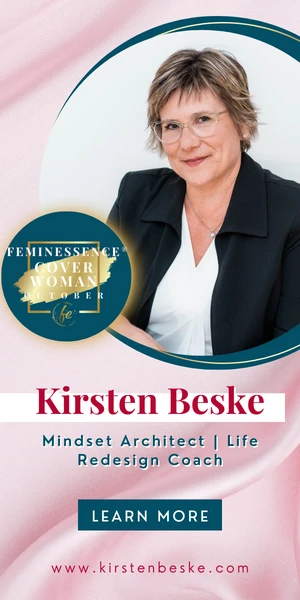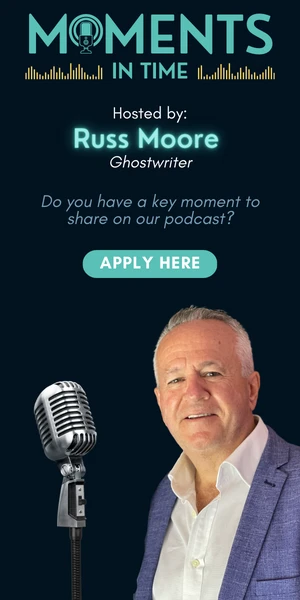Helping Clients Re-Discover Their Purpose and Passion
Kirsten Beske – Mindset Architect
Early Life & Role Model
Kirsten Beske grew up identifying as a cisgender female – with no caveats.
Things have changed, of course, but she knows the world still has a long way to go in its understanding of gender roles and equality. She remains a stalwart feminist but acknowledges that inclinations to support people moving out of their gender-limiting roles can’t be addressed without accepting that gender binary itself is a limiting construct.
Growing up in the 70s and 80s, Kirsten had one very unique role model: her mother, Carol Beske. In the 1970s, she was the Mayor of the town in which Kirsten grew up. At that time, it was not common to see women in positions of power, yet it felt normal to Kirsten that a woman could hold public power and still be a great mother. Carol ended up getting involved in Civil Engineering from the marketing side and eventually owned and ran her own Civil Engineering company for over 25 years. Observing her as the powerful and successful business owner she became over the years, and especially when Kirsten was young, really normalized for her that anything was possible, no matter one’s gender.
When she was younger, she chafed against more feminine conveniences like wearing dresses (you couldn’t jump, swing, wrestle, or run without someone seeing your underwear—pre-spandex days), wearing heels, being quiet, not showing up the guys, having one’s whole existence revolve around getting the attention of boys from how you looked to how you acted to your body shape, etc.
She disliked these culturally feminine signs as “weaker.” She strove to be the exception and was “the one” girl the boys let in the handball game on the playground. She was “the one” girl faster than the boys, “the one” girl on the baseball team, and was the “one girl” who was one of the guys.
Thankfully, there was simultaneously a cultural revolution going on where more and more women were allowed to be publicly powerful. More and more female athletes were allowed to compete at all levels, from little league to professional women’s tennis. Women could be lawyers, doctors, politicians, and business owners.
Feminessence & Gender Fluidity
Today, female-identified folks have moved into board rooms, CEO roles, politics, and other places of public power. There are so many women whose personal efforts and sacrifices are to thank for these increased opportunities. We have countless role models of women being women, paving the way to wield power differently from the men who have come before. In the future, Kirsten suspects, there will be a still wider lens on gender identity, which will be more inclusive for so many people who fall in the middle of the spectrum. We are privileged to be able to participate in another entire evolution of increased equity, where the finer aspects of gender, gender fluidity, and a full understanding of the gender spectrum can enrich any discussion around femininity from all angles.
“I think of Billie Jean King, who was a pioneer in sports equity, as one of my role models for moving beyond the traditional tropes about females and embracing the full power of women to be strong, have a voice, be effective, and also as someone who has been able to normalize queer relationships for all of us in the present. She did so at much professional and personal cost,” remarks Kirsten.
As a female-identified person from birth who has also always had a lot of success athletically and professionally, Kirsten used to think her more masculine aspects contributed to her successes. Now, she sees that her unique balance of feminine and masculine energies truly makes her who she is.
“When I was younger, there may have been some internalized chauvinism from the culture in the 70s and 80s, where my feminine slides were not valued or cherished. Now, as a mother and out queer woman, I have been able to embrace my feminine traits as amazing strengths and valuable parts of myself, even more so than those more masculine traits. I think I am at my best and in my fullest power when my feminine and masculine sides are in harmony and working together to be ME in the world,” she explains.
“I was always an athlete for as long as I can remember. Here in the US, I was one of the first generations of women to benefit from Title IX, the law that attempted to equalize access for female athletes. As a result, when I wanted to play Little League Baseball in 4th grade, no one said no. As the only girl on my team for years, I felt just like one of the team (despite the jokes about me not having to wear a jock). Then, as puberty hit and the boys got bigger and stronger, I realized I could no longer keep up with them at the same level. It was a hard transition to make, from feeling equal to feeling different and “less than.’”
For Kirsten, this was the beginning of trying to make sense of gender inequality. How could an entire class of humans with a double XX gene be “less” than in all areas? In school, the girls were at least as intelligent as the boys. But, in the world, the males still seemed to dominate. And, each winter, when the Sports Illustrated Swimsuit Edition came out, she was reminded that females only got on the cover of Sports Illustrated if they fit the Playboy Bunny model of a man’s vision, not for their own merits as athletes. This lack of role models left a gap in Kirsten’s understanding of herself and what was possible for her as a woman. Even when she played tennis at Harvard, their #1 player, the top in the country, was on the cover of Cosmopolitan, looking sexy and kittenesque, ignoring the amazing, strong athlete that she was!
Becoming A Litigator
She clung to her identity as a female gender outsider for quite a while, including in her practice of law. As a female-identifying litigator, she was well in the minority when she first started practicing law. Sandra Day O’Connor remained the sole woman on the U.S. Supreme Court. The Anita Hill-Clarence Thomas Hearings took place when she was in law school. Ruth Bader Ginsburg was not seated on the high court until 1993 after she began her law practice. While women were certainly making inroads into the field, litigation remained a good ole boy network, especially when she moved from Boston to Vermont to practice with her then-husband.
“I learned that as hard as I would try to “fit in” to that world, I never was accepted as one of the guys. At some point, it occurred to me that maybe it was time to stop hitting my head against a brick wall and just stop trying to be one of them,” she says wryly.
Finding Her “Family”
When she finally met her “family” in the world of queer-identified women, she was struck by how “the feminine” could exist in its own lovely world, separate from and without the need of the patriarchy or any male-identified person to approve of, vet, judge, dominate mentor, or any other dynamic. While social, racial, and economic differences obviously exist in any group, her queer women friends showed her that women could be BOTH soft and tough, BOTH smart and cooperative, BOTH independent and cooperative, BOTH giving and receiving. This realization gave her a sense of freedom to embrace her feminine side in a way that she had never permitted herself to do before. It let her express her femininity in a way that didn’t feel weak but empowered. It allowed her feel whole as a person, without the need to put on a more masculine mask to get the respect she believed she deserved. It was very freeing and made everything feel lighter and more joyous.
“By freeing myself of my own internalized sexism, it really opened so many doors to being able to be my full authentic self. I no longer needed to be that “special one woman” exception. Instead, I was one of many amazing humans on the planet, many of whom had similar life experiences as me and were doing the best they could to contribute to and enjoy their time on the planet. The biggest personal gift it gave me, besides meeting my amazing wife, is that when my eldest child came out to me as non-binary, it let me both accept this new evolution of them as well as learn and expand my perspective on gender once again. If not for all the learning I had done before my child coming out, I may not have been as able to be as unequivocally supportive of them as I was. Since my relationship with them is one of my most prized relationships, it was well worth the journey and continuing to expand my understanding of gender! ”
The Meaning of Feminessence
To Kirsten, Feminessence means a combination of grace, strength, and compassion.
In her personal life, she has been able to transcend society’s limiting version of “female” and embrace her Feminessence, HER way. She divorced in 2012, with two kids aged 10 and 12, and had never lived fully independently on her own.
“Buying my own house, earning my own income, managing my own money, keeping up my property, raising my children, tending to the pets—all contributed to this amazing feeling of agency over my own life. Of course, I had great family and friends and other support along the way, but I did it for over a decade until the kids were in college. That experience of fully owning all the pieces of my life has let me now come out as gay and remarry into a very equitable and loving partnership with my wife and our (now 5!) kids. To me, Feminessence represents ALL my agency, grace, and power, as well as the softness, compassion, and loving-kindness combined into one.”
In business, her Feminessence really is the backbone of her success in her coaching programs. It is her Feminessence that lets her walk alongside clients in their experiences instead of pretending to lead from behind. Her Feminessence allows her to have good boundaries while also being empathetic and kind. Her Feminessence allows her to help clients grow into their true, powerful selves in a supportive, holding, and validating container. It gives her the strength to evolve, learn, and tolerate not being perfect in her business growth journey. Feminessence is a source of truth, energy, and light that helps define her journey of serving others in their journey.

Becoming a Mindset Architect
Kirsten’s desire to lift other women into their full power and potential sparked the launch of her coaching business. Her personal experience of switching from being a successful partner at a law firm to a clinical psychotherapist to an ICF-certified coach made her intimately aware of the challenges it takes to craft a new personal identity later in life, especially having had some mastery in your field.
She stopped practicing law in 2006, went back to get her Masters in Clinical Psychology, and ran a private psychotherapy practice for over a decade. When she first learned about Positive Psychology or the science of how humans thrive, she was hooked! She loved the idea that instead of studying all that was wrong with people (traditional psychology), now there was evidence-based research on what contributed to people feeling satisfied and fulfilled in life. She then decided she wanted the world to know about all the amazing ways to live your life by design and maximize your ability to thrive and be happier!
Her Next Spark Accelerator coaching programs are built to help already successful women entrepreneurs and professionals redesign their businesses and lives for more authenticity, passion, purpose, and ease. Kirsten developed these programs out of her love of behavioral science, positive psychology, and the science of how we thrive as humans. She developed a three-part framework that she worked through over six months, customized to each person as they designed the life they wanted.
“In my experience (and as the research shows), the more you know yourself, your strengths, values, sense of purpose, passions, and your desired impact on the world, and take empowered steps toward a vision incorporating all these, the happier and more fulfilled your life will be. Too many women inadvertently get stuck in the “should’ or “should not” or the “what will they think” or the “what if I fail” or the “it has to be perfect.’ These thought patterns can stop you in your tracks before you even begin to dream of what is possible. When you apply a growth mindset to what is possible and make sure you are operating authentically within your values, passions, skills, and purpose, almost any vision can become a reality,” Kirsten says.
She was inspired to put together her Next Spark Accelerator program when she worked briefly in a private educational setting, where she watched so many talented women wasting away in a system that would never reward or acknowledge all the amazingness they brought to work every day. Instead of changing “the system,” she believes that if each of us can dig deep within and see how amazing we are, we can move past any box that people try to put us in. That is true freedom—something she wishes for every one of her clients. Full permission to be themselves and to be respected, acknowledged, and paid for their brilliance.
Kirsten also offers a 90-day Calibrate to Accelerate program for women who would like to feel confident, engaged, and aligned in their next chapter of life. She identifies each client’s North Star, that point of intersection of purpose, passion, engagement, and knowledge so that they can begin to see all that is possible in the next chapter of work and life.
Future Programs & Legacy
As a Mindset Architect, Kirsten is uniquely positioned to help established business owners break through inner glass ceilings and redesign their worldview to really come into their full power. She loves helping leaders who are already making big impacts both reach their full potential and take care of themselves so that they enjoy the journey along the way.
“I would like to keep serving my clients by designing for themselves the best chapters of their work and lives. So much of this work is inner work—opening to what is possible and not letting our limiting beliefs get in the way. As I age, I see more and more of a need for folks in their 50s and 60s to design their next chapters to both apply all their accumulated wisdom and knowledge in a useful way and to construct a different work-life balance that lets them enjoy parts and pieces of life they may not have been able to due to their earlier professional ambitions, family responsibilities, or financial needs. Not everyone wants to ‘quit’ working and play golf (although that is fun, too!). So, how do we construct a life of meaning when we are no longer working full-time? The principles of how we thrive as humans can be applied to this stage of life as well! So, I love the idea of applying my life redesign framework to the semi-retiree population on a larger scale in the future.
“I would like to leave as my legacy a trail of inspired leaders who have been empowered to embrace their own uniqueness and to shine their bright lights in the world for the rest of us to see, enjoy, and learn from. My voice is most clear and steady when I defend people’s right to be themselves. My quote in my senior yearbook, before I attended Harvard, was from Henry David Thoreau’s Walden:
“If a man does not keep pace with his companions, perhaps it is because he hears a different drummer. Let him step to the music that he hears, however measured or far away.”
This is a fundamental belief I have always held: that each of us is different, unique, and blessed in our own way. And that each of us should respect and cherish our differences.”




